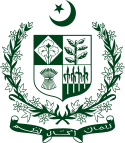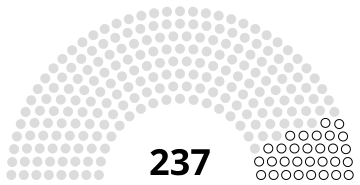 |
|---|
|
|
General elections were held in Pakistan on 25 February 1985 to elect members of the National Assembly.[1] The elections were held under the military government of Muhammad Zia-ul-Haq after the restoration of the 1973 constitution.
Around 1,300 candidates contested the elections, which were held on a nonpartisan basis.[2] Each candidate was required to have their nomination paper signed by 50 registered voters from the constituency they wished to stand in.[3] In an attempt to disqualify a large number of opposition candidates and secure a conservative leadership, Zia-ul-Haq introduced amendments to the Political Parties Act of 1962. As a result, the Movement for the Restoration of Democracy (MRD), which was calling for an end to the military regime, boycotted the elections.[4]
Voter turnout was 54%. Most of the elected MNAs were supporters of the Zia regime. A new government was formed under the leadership of Muhammad Khan Junejo, a lesser known figure in national politics. Prime Minister Junejo and his followers subsequently established the pro-Zia conservative Pakistan Muslim League.
Results
 | ||||
|---|---|---|---|---|
| Party | Votes | % | Seats | |
| Independents | 16,889,392 | 100.00 | 217 | |
| Seats reserved for women | 20 | |||
| Total | 16,889,392 | 100.00 | 237 | |
| Valid votes | 16,889,392 | 96.69 | ||
| Invalid/blank votes | 578,641 | 3.31 | ||
| Total votes | 17,468,033 | 100.00 | ||
| Registered voters/turnout | 32,528,996 | 53.70 | ||
| Source: FAFEN | ||||
Aftermath
Following the elections, Muhammad Khan Junejo was appointed Prime Minister and later formed a new party, the Pakistan Muslim League. The election boycott was viewed to have been a misstep for the MRD, which had assumed the public would support its stance.[4]
References
- ^ Pakistan Inter-Parliamentary Union
- ^ Dieter Nohlen, Florian Grotz & Christof Hartmann (2001) Elections in Asia: A data handbook, Volume I, p678 ISBN 0-19-924958-X
- ^ Report on the General Elections, 1985, Election Commission of Pakistan, 1986, p300
- ^ a b General Elections, February 1985 Story of Pakistan




Recent Comments